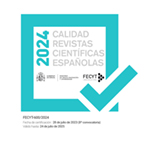Claves de actuación para la interpretación de la lengua de signos española en el ámbito religioso
Resumen
Los (con)textos religiosos son uno de los grandes desafíos para intérpretes y traductores/as por el simbolismo y el lenguaje que los caracteriza. Su interpretación a/desde las lenguas de signos requiere valorar la diferencia de modalidad entre ambas lenguas. Ante la escasez de recursos para las intérpretes de lengua de signos española (LSE), el presente trabajo supone una propuesta teórica de pautas de actuación para estas profesionales en dicho ámbito. Para ello, se empleó el modelo de comunicación humana de Escandell Vidal (2005) y se adaptaron algunos de sus postulados a la interpretación signada, complementándolos con referencias de diversas áreas. Se pretende así que este documento sirva de guía para estudiantes, profesionales y formadores de la interpretación de LSE y, consecuentemente, repercuta en la vida de las personas sordas.
Descargas
Descarga artículo
Licencia
La revista Estudios de Traducción, para fomentar el intercambio global del conocimiento, facilita el acceso sin restricciones a sus contenidos desde el momento de su publicación en la presente edición electrónica, y por eso es una revista de acceso abierto. Los originales publicados en esta revista son propiedad de la Universidad Complutense de Madrid y es obligatorio citar su procedencia en cualquier reproducción total o parcial. Todos los contenidos se distribuyen bajo una licencia de uso y distribución Creative Commons Reconocimiento 4.0 (CC BY 4.0). Esta circunstancia ha de hacerse constar expresamente de esta forma cuando sea necesario. Puede consultar la versión informativa y el texto legal de la licencia.









